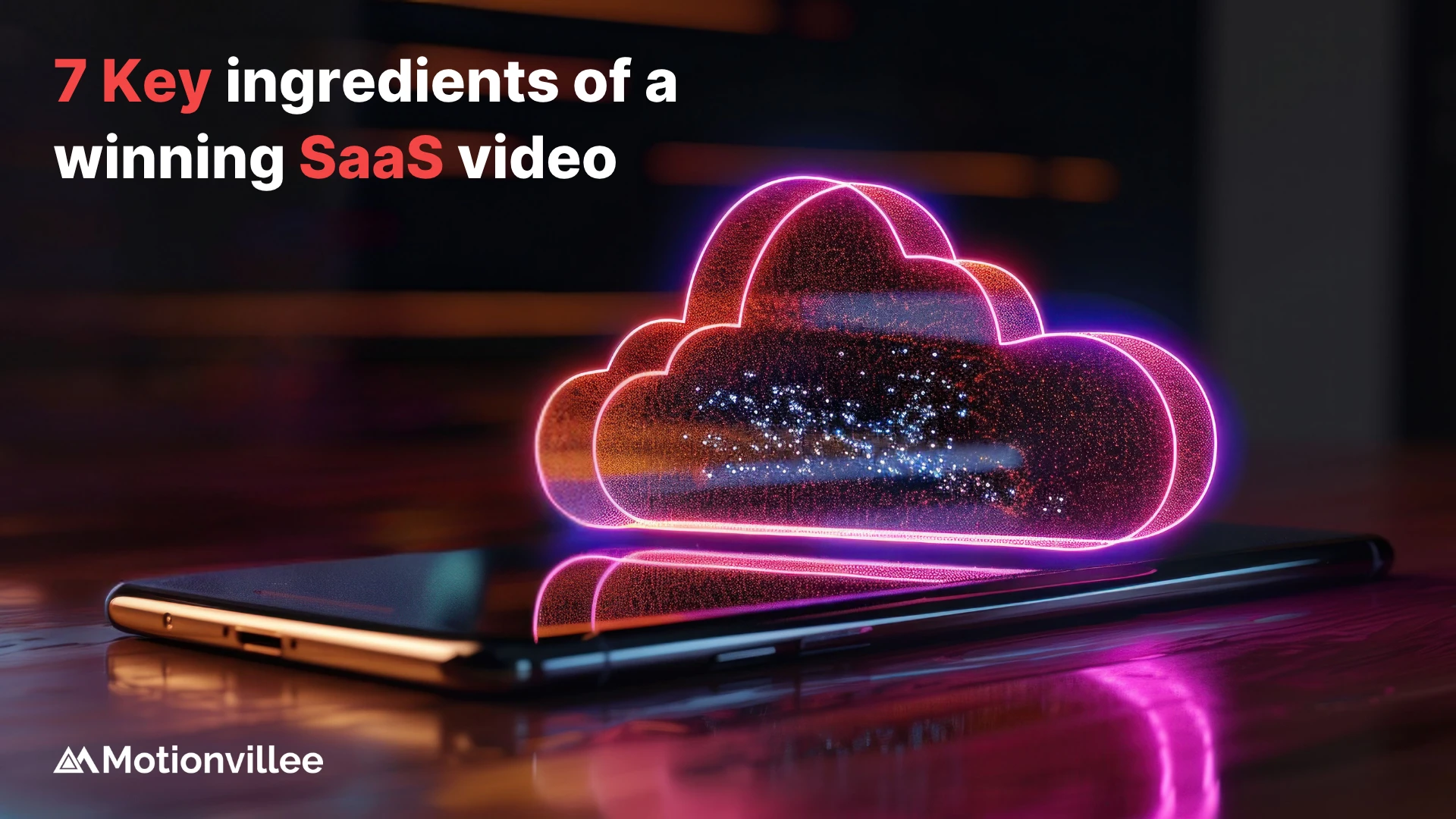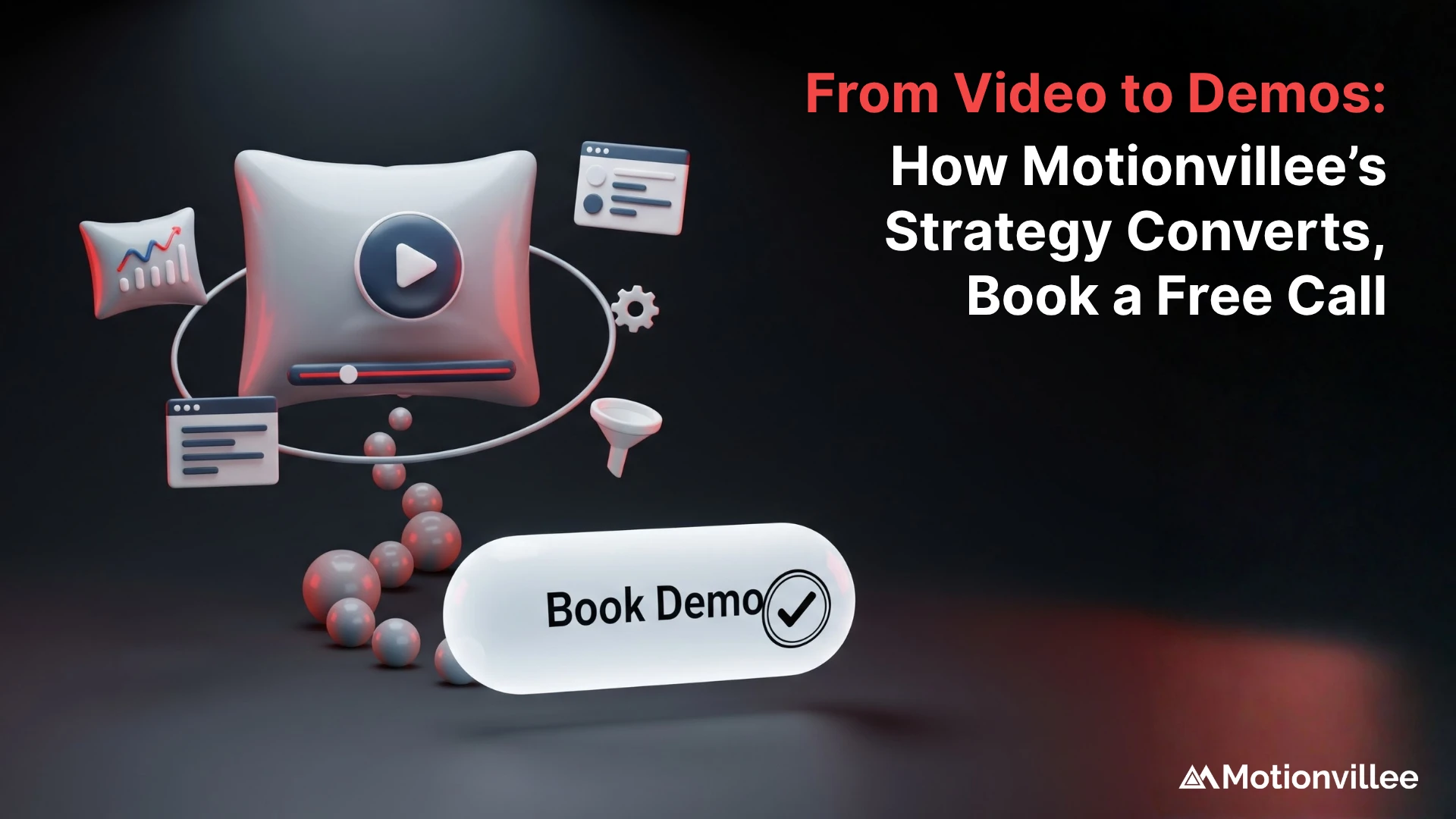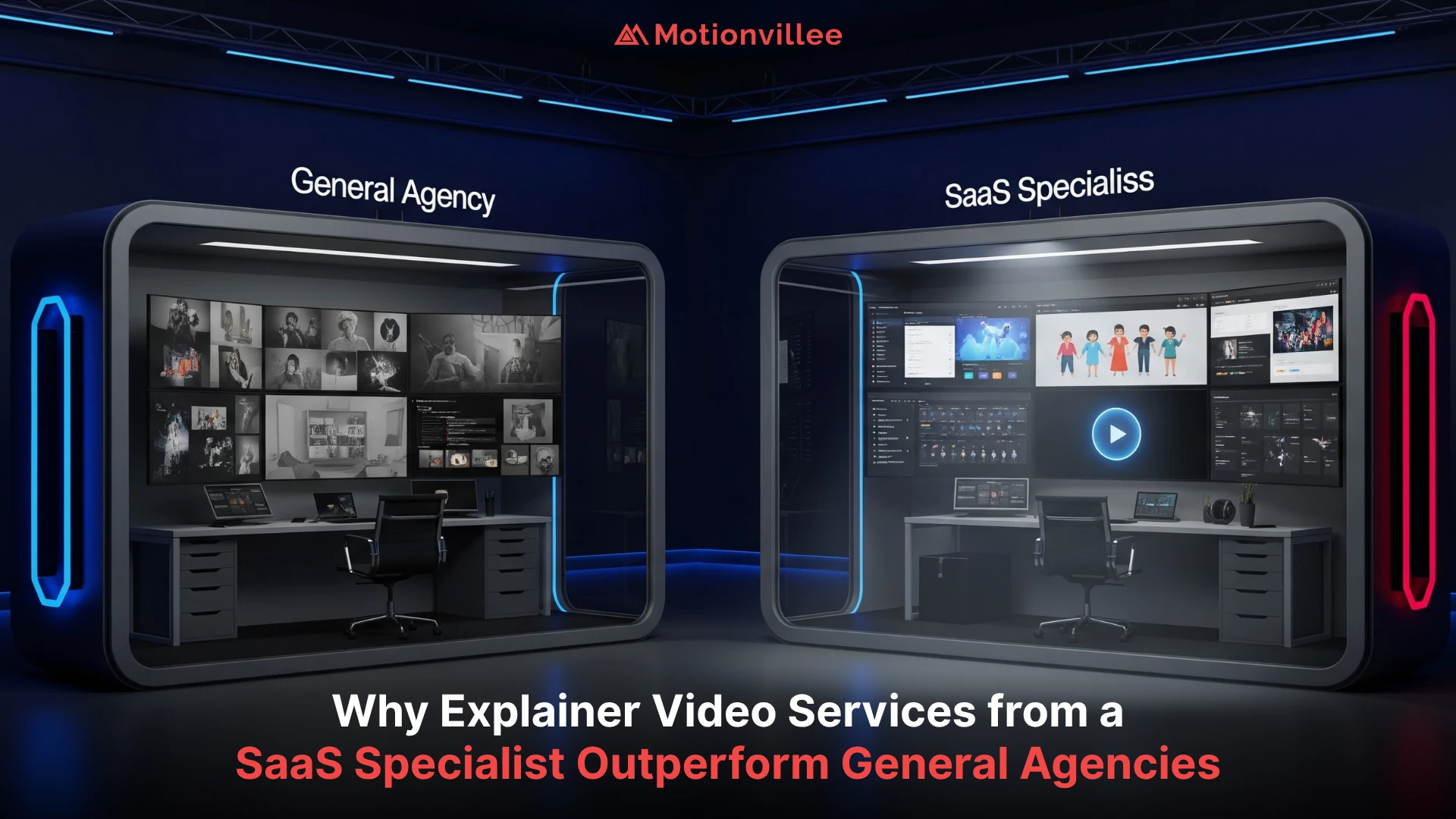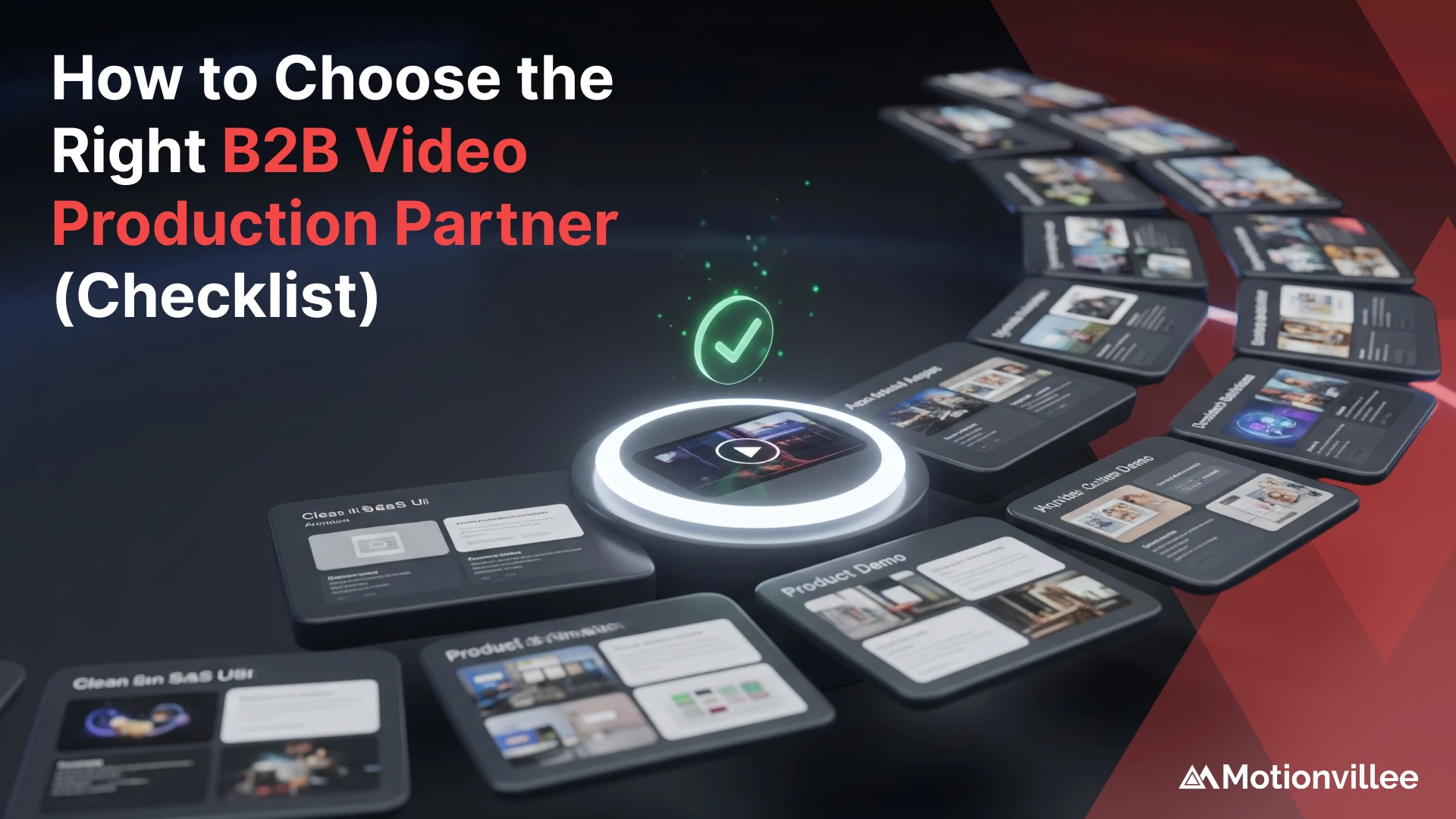A great SaaS video does more than look good. It explains, engages, and converts. But most SaaS videos miss that mark.
They often:
- Focus too much on style
- Ignore the sales funnel
- Use buzzwords without clarity
- End without a next step
The real difference is not fancy animation. It is strategy.
Strong videos are built on clear goals and a sharp message. They support your B2B SaaS video strategy across marketing and sales.
At Motionvillee, we help brands align visuals with outcomes. That is what sets high-performing SaaS video production apart.
In this blog, we’ll break down 7 key elements that make SaaS videos work. Whether you’re launching your first video or fixing what is not working, this guide will help you move forward with clarity.
1. It Starts with Strategy, Not Style
Before you think about animation style or voiceover tone, start with one question: What do you want your SaaS video to achieve?
Too many teams jump into production without answering:
- Who is the video for?
- What stage of the funnel are they in?
- What action should they take after watching?
These are not small details. They shape the entire creative process.
Here’s how to build from strategy:
- Define your audience clearly
- Choose a message that speaks to their pain point
- Set one primary goal for the video
- Match the video format to where it lives (landing page, sales deck, email, etc.)
For example, a top-of-funnel explainer should feel different than a mid-funnel product walkthrough.
Every effective SaaS video has a job to do. And that job should be clear to everyone involved, before the first frame is drawn or recorded.
When strategy comes first, creative choices follow with purpose. That is how videos turn into assets, not just content.

2. Hook the Viewer in 3 Seconds or Less
In a scroll-first world, attention is earned fast or not at all. Even a great SaaS video will be skipped if the opening does not grab the viewer instantly.
The first three seconds decide whether someone keeps watching. That means no slow intros, no logo animations, and no generic setups.
What should you use instead?
- Start with a bold statement that challenges a belief
- Ask a question your audience is already thinking about
- Show the problem before introducing your product
- Jump straight into the action or value
Here are examples of strong opens:
- “Tired of juggling 5 tools to manage one task?”
- “What if your onboarding took 90 seconds instead of 9 days?”
- “Let me show you how to spot a churn risk before it happens”
Keep the visuals moving, keep the message tight, and always speak to the viewer’s problem first.
A great open sets the tone and earns trust. Without it, the rest of your video might never get seen.
3. Keep It Clear, Not Just Clever
Clever scripts can grab attention, but clarity is what converts. A saas explainer video should make it easy for the viewer to understand what your product does and why it matters.
When videos get too abstract or overloaded with features, people tune out. The best SaaS videos focus on delivering one clear idea at a time.
Tips for staying clear:
- Use everyday language instead of buzzwords
- Break complex ideas into small, visual steps
- Show real product use cases, not just animation
- Stick to one core message per scene
Visuals play a key role here. They should simplify, not distract. When done well, they help explain workflows and product outcomes in seconds.
If you’re planning a top-level explainer, it’s worth reviewing your script and visuals through the lens of clarity. That is what we focus on in our brand explainer video production work, making sure the viewer walks away with zero confusion.

4. Design with Your Brand in Mind
A great SaaS video should feel like it belongs to your brand, not just any SaaS company. If the visuals, tone, or pacing feel off, it creates a disconnect that weakens trust.
Too often, teams fall into the trap of using template animations or generic voiceovers that could apply to any product. The result? A video that looks polished but forgettable.
Here’s how to keep it on-brand:
- Use your brand colors, fonts, and design elements
- Match the tone of your voiceover to how your team actually speaks
- Keep the pace consistent with your audience’s expectations
- Add product UI and use-case visuals that reflect your real customers
Design choices should not just be about looking good. They should reinforce who you are and how you solve problems.
Your video should be instantly recognizable as yours, even without the logo. That kind of consistency builds brand memory and helps your message stick.
When your visual style supports your story and your strategy, you create more than a video. You create an experience that connects.
5. Tailor the Video to the Funnel Stage
One video cannot do everything. A common mistake is trying to pack every message, feature, and CTA into a single asset. The result is a video that says a lot but lands nothing.
A great SaaS video speaks to where the viewer is in their journey. Each stage of the funnel calls for a different approach.
Top of funnel (Awareness):
- Focus on the problem, not the product
- Keep it short, visual, and story-led
- Spark curiosity and interest
Middle of funnel (Consideration):
- Show how your product solves specific problems
- Include UI walkthroughs or feature highlights
- Answer the “how does this help me?” question
Bottom of funnel (Conversion):
- Build urgency with proof and outcomes
- Use testimonials, case studies, or short demos
- Include a clear and relevant CTA
When you match the video to the moment, it feels more relevant. That’s what keeps people watching, clicking, and moving forward.

6. Structure It for Performance
A great SaaS video is not just well written and designed, it is built for how people actually watch. The structure, length, and format all play a role in whether it gets seen, understood, and acted on.
Each platform has its own rhythm. Your video should match that.
Social (LinkedIn, YouTube Shorts, etc.):
- Keep it under 60 seconds
- Add captions for silent viewing
- Front-load the message in the first 5 seconds
Websites and landing pages:
- Aim for 60 to 90 seconds
- Use a strong headline and video thumbnail
- Place the video above the fold
Email and sales follow-ups:
- Keep it under 45 seconds
- Focus on one point only
- Use animated previews to boost clicks
Other small but critical tips:
- Always design for mobile first
- Use readable text and clear voiceover pacing
- End with a real next step, not just a fade out
When your video is structured for where and how it will be viewed, it performs better by default. It respects the viewer’s time and increases the chance they stay with you till the end.
7. Close with a Real CTA (Not Just a Logo)
The ending of your video is just as important as the beginning. A great SaaS video should not fade out with a logo or a vague message. It should give the viewer one clear next step.
Your call to action should match where the viewer is in the funnel.
Top of funnel:
- Invite them to watch another video
- Link to a product overview or feature page
Middle of funnel:
- Offer a demo, use case, or customer story
- Encourage exploring key features
Bottom of funnel:
- Prompt a trial, sign-up, or sales call
- Make it feel low-pressure and specific
Avoid soft endings like “Thanks for watching.” Use direct CTAs like:
- “Start your free trial”
- “Book a live demo”
- “Get your custom walkthrough”
Make sure the CTA is both spoken and shown on screen. Add a visual button or link if the platform allows.
A clear CTA keeps your momentum going and helps your video deliver real results.

What to Do Next: Build Smarter SaaS Videos
Strong SaaS videos are not made by accident. They are built with clear thinking and creative discipline.
Let’s recap the 7 elements of a great SaaS video:
- Start with strategy, not style
- Hook the viewer early
- Keep the message clear
- Match the design to your brand
- Align content to the funnel stage
- Structure it for where it will be watched
- End with a real CTA
If your current videos miss even one of these, it may be time to step back and rethink your approach. Review what you have, see where the gaps are, and plan for what your next video should really do.
If you are building or refreshing your video library, Motionvillee can help. From concept to delivery, we focus on strategic clarity as much as creative quality.
Have questions or want to explore ideas? Schedule a call with our team to talk through your goals.






